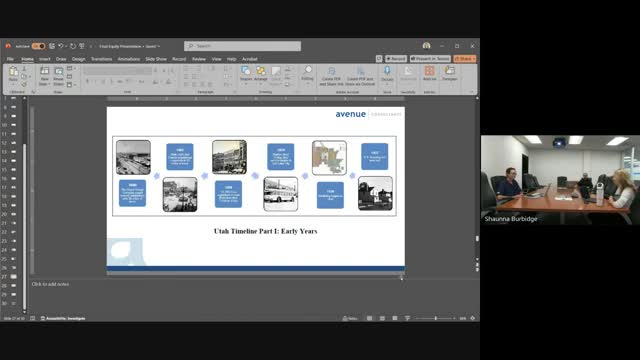Utah's suburban boom reshapes transportation and housing landscape
October 13, 2024 | Utah Department of Transportation, Utah Government Divisions, Utah Legislative Branch, Utah
This article was created by AI summarizing key points discussed. AI makes mistakes, so for full details and context, please refer to the video of the full meeting. Please report any errors so we can fix them. Report an error »

In a recent government meeting, officials discussed the historical evolution of transportation and urban development in Utah, highlighting key milestones from the late 19th century to the present. The conversation began with the establishment of rapid transit in Salt Lake City in 1890, which laid the groundwork for a growing network that expanded to 80 miles by 1903. The rise in automobile ownership was noted, with registered vehicles increasing from 7,000 in 1914 to 91,000 by 1926, marking a shift towards recreational driving rather than daily commuting.
The introduction of rubber-tired buses in 1928 and the subsequent implementation of redlining practices in 1934 were pivotal moments that shaped the region's transit landscape. The 1937 US Housing Act aimed to provide homes for all Americans, leading to widespread suburbanization, particularly after the introduction of VA loans for returning veterans.
The meeting also addressed the impact of infrastructure developments, such as the construction of I-15 beginning in 1957, which facilitated suburban expansion and contributed to what was described as \"white flight\" to the suburbs. The Bamberger rail line, operational during this period, further supported this trend.
Environmental regulations began to emerge with the Air Quality Act of 1967, and the Fair Housing Act of 1968 sought to eliminate redlining. Despite these advancements, the discussion emphasized ongoing challenges in addressing the needs of established urban areas, particularly as new developments proliferate in more affordable, exurban regions.
As Utah continues to experience rapid population growth, officials acknowledged the increasing reliance on automobiles, raising concerns about the adequacy of existing infrastructure and the need for comprehensive planning to meet the demands of both new and established communities.
The introduction of rubber-tired buses in 1928 and the subsequent implementation of redlining practices in 1934 were pivotal moments that shaped the region's transit landscape. The 1937 US Housing Act aimed to provide homes for all Americans, leading to widespread suburbanization, particularly after the introduction of VA loans for returning veterans.
The meeting also addressed the impact of infrastructure developments, such as the construction of I-15 beginning in 1957, which facilitated suburban expansion and contributed to what was described as \"white flight\" to the suburbs. The Bamberger rail line, operational during this period, further supported this trend.
Environmental regulations began to emerge with the Air Quality Act of 1967, and the Fair Housing Act of 1968 sought to eliminate redlining. Despite these advancements, the discussion emphasized ongoing challenges in addressing the needs of established urban areas, particularly as new developments proliferate in more affordable, exurban regions.
As Utah continues to experience rapid population growth, officials acknowledged the increasing reliance on automobiles, raising concerns about the adequacy of existing infrastructure and the need for comprehensive planning to meet the demands of both new and established communities.
View full meeting
This article is based on a recent meeting—watch the full video and explore the complete transcript for deeper insights into the discussion.
View full meeting

